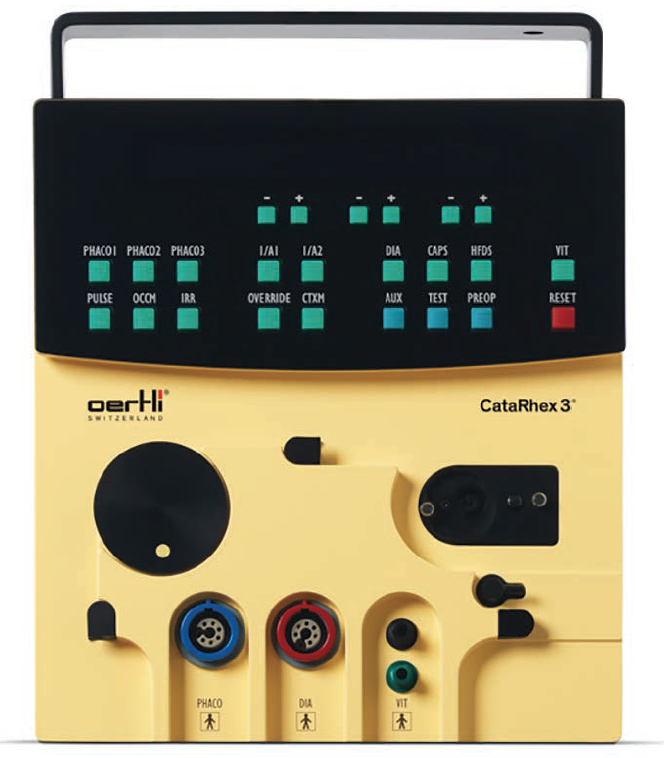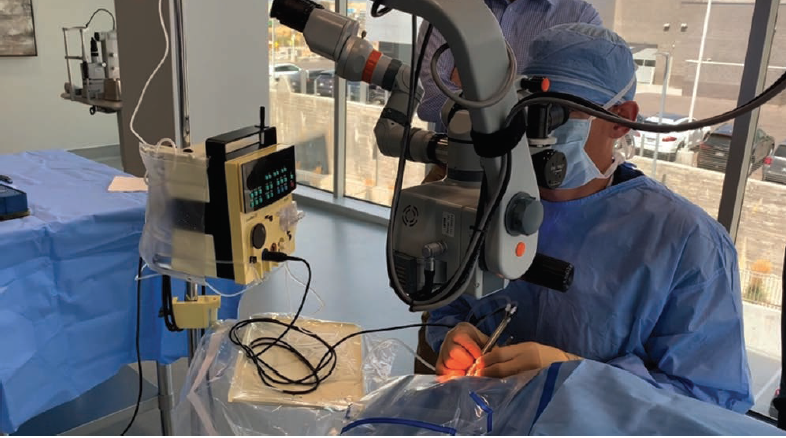Last year, I opened my own cataract and refractive practice with an in-office surgical suite. I created Waite Vision in Lehi, Utah, with the objective of providing a patient experience that is high-touch and high-tech, allowing patients to feel relaxed and confident with having vision correction. This priority went into every aspect of planning, from the aesthetic appeal of our reception area and smooth no-wait visit, to the bright, airy surgical suite where I perform vision correction including LASIK, ICLs, refractive lens exchange, and refractive cataract surgery.
To offer the best visual results, I decided to invest in what I felt was the best technology. As part of my surgical technology suite, I chose the CataRhex 3 (Oertli Instrumente AG, Switzerland, Figure 1) surgical platform for phacoemulsification. I had a positive experience with the system in my previous role as Director of Cornea, Cataract, and Refractive Surgery at the University of Tennessee in Memphis. After using the CataRhex 3 for just a few cases, I was convinced that it was a fantastic machine with excellent fluidics. I continued to use it at the University of Tennessee for hundreds of cases. This experience convinced me to acquire a new machine to complement the other top technology at Waite Vision (Figure 2).

Figure 1. The portable but powerful CataRhex 3 by Oertli.

Figure 2. Dr. Waite uses the CataRhex 3 during refractive cataract surgery at Waite Vision.
First Impressions of the CataRhex 3
I chose the CataRhex 3 for its astounding performance in the OR. On first glance, it looks different than other devices, but looks can be deceiving. In a technology environment where bigger is better, touch screens dominate, and there is an ever-changing stream of available features, the CataRhex 3 is completely different. It is small; there is no touch screen—just button controls for easy and direct access. I quickly learned that these features make the CataRhex 3 easier to use and more reliable than other phaco machines.
The CataRhex 3 has a small and unassuming footprint. It is easy to move the device from room to room, and it can literally be held in one hand. Setup is easy with the CataRhex 3, requiring only a few seconds. With the touch of a single button, access is gained to the surgeon settings that are fully customizable for up to 20 surgeons. Resetting the machine takes about 3 seconds with the push of a button. There is no long boot-up time because each button sends a simple signal right to the destination without deviating through software or a graphics user interface. The CataRhex 3 has an integrated, self-developed operating system that eliminates software malfunctions. There is no software that needs to be constantly updated or an unreliable operating system that is susceptible to glitches. It is built to be durable and reliable. It does not stop or break down; it just works.
Side-by-Side Comparison
At the University of Tennessee, I performed cataract surgery by going back and forth between two ORs that had two different phaco machines. In the first room was the CataRhex 3, and in the second room was another current-model phaco machine. For years, I had the opportunity to make a direct head-to-head comparison of the two platforms.
I used a very similar technique with both machines. My preference is to use a vertical chop technique, cutting the nucleus into four pieces. Afterwards, I remove the quadrants one at a time. The disposable phaco tip on the CataRhex 3 has a flange design that is large at the front and thin in the center. This allows more fluid to enter the anterior chamber than is removed, preventing surge and keeping the anterior chamber stable and open. There is always more fluid inside the eye than can be removed without having to force fluid into the eye with pressure. Between the two machines, the CataRhex 3 seemed to maintain the anterior chamber better while at the same time holding the capsule posteriorly and keeping the iris still. This allows for a very safe procedure. I never have to worry about breaking the capsule or having the capsule come close to the tip as the CataRhex 3 features the easyPhaco technology (Oertli Instrumente AG, Switzerland), which is based on physics and fluidics.
During cataract surgery, care needs to be taken as we remove the last quadrant. With the CataRhex 3, the iris does not bounce, and the posterior capsule stays completely posterior. Movement of fluid through the eye is slow, yet the system’s efficiency means I finish a bit faster with the CataRhex 3 compared to other systems.
Dense lenses are not a problem with the CataRhex 3. I have used it on a variety of cataracts including very dense cataracts while on mission trips to third-world countries. It handles both soft and hard lenses efficiently. The phaco tip design attracts the nucleus and holds on tightly while allowing the flow of fluid to continue. Finally, there is never a concern for wound burn with this kind of machine; the phaco handpiece never gets hot because of the large flow of fluid through the sleeve.
Other important considerations that convinced me to use an Oertli CataRhex 3 include customer service and flexibility with IOLs. Oertli is a small, passionate, Swiss company that believes in making the best technology better and simpler. They have proved it with the design of the CataRhex 3. It is everything the other phaco machines declare themselves to be, while at the same time being a fraction of the size, cost, and complexity. The customer service I have received is second to none. Oertli is easy to work with, and they are passionate about what they do. Their service representatives take all the time necessary to train new surgeons in the use of the machine and take great care of existing accounts. Since Oertli is not an IOL company, I am free to use any IOL design or brand I prefer without any obligation or rebate program. I have the freedom to choose the best IOL design for each of my patients.
Safer for Challenging Cases
The CataRhex 3 has controlled fluid exchange and minimal phaco energy, making it ideal in the setting of compromised corneas. In patients with a previous corneal transplant or with Fuchs dystrophy, it is able to safely remove the cataract while preserving endothelial cells. This helps make postoperative corneas as clear as possible. Because of this, the CataRhex 3 works very well in premium cases, reaching great refractive outcomes and maintaining clear corneas with or without the use of a femtosecond laser.
The CataRhex 3 works very well for anterior vitrectomy, if needed. The integrated air compressor controls the cut speed, which ranges from a single cut at up to 1,200 or 2,400 cpm depending on the type of cutter. The disposable vitrectomy handpiece comes standard with a 23- or a 25-gauge tip, which can be used through a limbal approach or pars plana through a trocar. With this setup, the vitrectomy is very safe, precise, and controlled.
All of these experiences with the CataRhex 3’s efficiency, stability, safety, and ease of use convinced me to invest in the Oertli CataRhex 3 for Waite Vision. For surgeons who have not tried the CataRhex 3, Oertli will set up a trial of the device and help optimize settings during surgical cases. It is worth the trial to experience the advantages of the CataRhex 3. My patients have certainly benefited from my decision to use this device.




